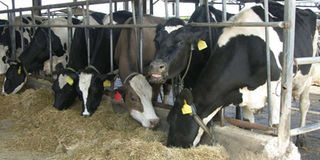With fodder, plan now for rainy day

Friesians feed at the Chemusian Farm in Nakuru. Strategic livestock farming involves planning for the drought during the rainy season through feed and fodder production and conservation. PHOTO | LEOPOLD OBI | NMG
What you need to know:
- Maize is commonly used for silage production but there is a wide range of fodder that can be used, which include napier grass and fodder sorghum.
- Planting holes should be about 15cm deep in which a handful of manure and fertiliser mixed well with soils have been put.
- Varieties like Kakamega 1&2 have been reported to produce up to 20 tonnes dry matter per acre per year. It can also be used to make hay.
- Hay is best done at flowering stage (80-90 days) and seeds are mature from 135 days. It produces 150-200 bales per acre or grains 10 –12bags per acre.
Strategic livestock farming involves planning for the drought during the rainy season through feed and fodder production and conservation.
While hay and silage-making are a common practice, briquetting is yet to be adopted.
Silage
Materials to be used for silage production should have high levels of fermentable substrates and should also be in a physical form that allows compacting.
Maize is commonly used for silage production but there is a wide range of fodder that can be used, which include napier grass and fodder sorghum.
a) Napier grass is a perennial grass with a vigorous creeping root system. It prefers deep, fertile loam soils and high rainfall areas of 1,500mm and above per year.
It can be planted through root cuttings or canes with at least three nodes and two nodes that should be covered with soil and in a slanting position.
Planting holes should be about 15cm deep in which a handful of manure and fertiliser mixed well with soils have been put.
Plant 4,000 canes of three internodes each per acre with spacing of 1x1m. It is expected to reach maturity in 5-6 months for first cutting depending on weather.
Production is 12-14 tonnes of dry matter per acre, per year at eight weeks interval or 16-20 tonne per acre of fresh material when cut at 4-6 weeks interval.
Varieties like Kakamega 1&2 have been reported to produce up to 20 tonnes dry matter per acre per year. It can also be used to make hay.
b) Fodder sorghum is a high-yielding, drought-resistant crop that requires medium fertile soils. It is propagated by use of seeds. Fine soil is best for seed drilling.
Use planting fertiliser at the rate of 50kg per acre and thin plants when 15cm high to 10cm intra plant. Seed rate is 3kg per acre and spacing 75cm.
The plant is expected to reach silage-making age at 7-8 months and production ranges between 28-40 tonnes per acre of silage material.
Ensiling destroys chemical substances present in fresh material, which may cause indigestion or death and taint in milk.
Always consult an expert when preparing silage to avoid producing compost instead of silage.
Hay
While Boma Rhodes and Kikuyu grasses are commonly used to produce hay, common vetch, lucerne and oats grass offer good alternatives.
a) Common vetch is a short-term crop of high nutritive value, has a rapid growth rate, can be grown as a pure stand or a mixed stand with grasses or and with fodders like oats, barley and napier. It requires soils of neutral pH (6-7).
Plant spacing is 45cm and drilling is recommended. The seed rate is 5kg per acre in pure stand or 3kg per acre when intercropped with grasses and fodders. It reaches hay production stage at 120 days and produces 150-300 bales per acre.
b) Lucerne is a high-yielding, high-protein perennial plant that grows upright to about a metre. It has a productive life of 4-6 years and does well when not mixed with other plants. It is drought-resistant and prefers well-distributed rainfall of 870mm and above. The soils should be well-drained with a pH of 6-6.5.
It is propagated by use of seeds and planting is through drilling. It can also be broadcasted or sown at a depth of not more than 10cm.
The required seed rate is 6kg per acre with a spacing of 20x25cm. It reaches hay-making maturity at 4-5 months and produces 375-550 bales per acre per year with a cutting interval of 4-8 weeks.
Lucerne can also be used to make silage.
c) Oats is a tall cereal widely grown as fodder in tropical and subtropical countries. It tolerates cold weather and makes good hay and grains.
Its crude protein content is improved by growing it mixed with vetch. The seed rate is 30-40kg per kilo per acre and can be planted by drilling or broadcasting with a spacing of 15cm.
Hay is best done at flowering stage (80-90 days) and seeds are mature from 135 days. It produces 150-200 bales per acre or grains 10 –12bags per acre.
Dr Mwirigi is the deputy principal, Ahiti-Nyahururu. [email protected]




